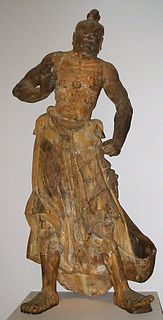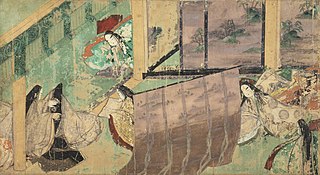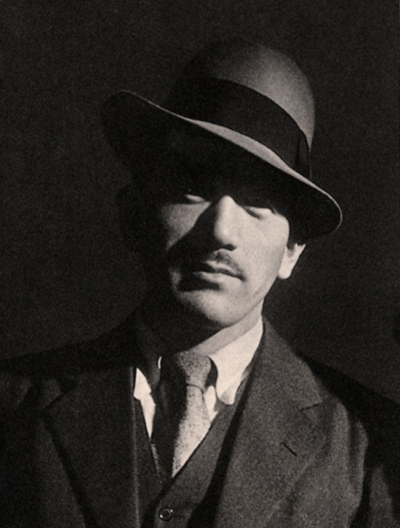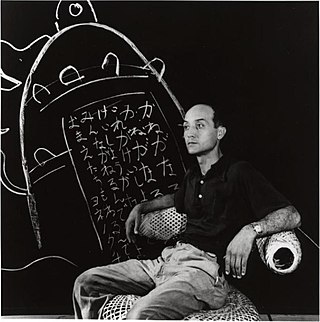
Shōkozan Tōkei-ji (松岡山東慶寺), also known as Kakekomi-dera (駆け込み寺) or Enkiri-dera (縁切り寺), is a Buddhist temple and a former nunnery, the only survivor of a network of five nunneries called Amagozan (尼五山), in the city of Kamakura in Kanagawa Prefecture, Japan. It is part of the Rinzai school of Zen's Engaku-ji branch, and was opened by Hōjō Sadatoki in 1285. It is best known as a historic refuge for women who were abused by their husbands. It is for this reason sometimes referred to as the "Divorce Temple".

Ōfuna Kannon Temple is a Buddhist temple in Kamakura, Kanagawa Prefecture, Japan. The outstanding feature of the temple is a 25 metres (82 ft), 1900-ton reinforced concrete statue of the bodhisattva Kannon.

Ton Satomi is the pen-name of Japanese author Hideo Yamanouchi. Satomi was known for the craftsmanship of his dialogue and command of the Japanese language. His two elder brothers, Ikuma Arishima and Takeo Arishima, were also authors.

Musō Soseki was a Rinzai Zen Buddhist monk and teacher, and a calligraphist, poet and garden designer. The most famous monk of his time, he is also known as Musō Kokushi (夢窓国師), a honorific conferred to him by Emperor Go-Daigo. His mother was the daughter of Hōjō Masamura (1264-1268), seventh Shikken (regent) of the Kamakura shogunate.

Kita-Kamakura Station is a railway station on the Yokosuka Line in Kamakura, Kanagawa, Japan, operated by East Japan Railway Company.

Tōji-in (等持院) is a Buddhist temple of the Rinzai Tenryū sect located in Kita Ward, Kyoto, Japan, and one of two funeral temples (bodaiji) dedicated to Ashikaga Takauji, first shōgun of the Ashikaga dynasty. Its main object of worship is Shakyamuni, and its honorary sangō prefix is Mannenzan (萬年山).

Kinpōzan Jōchi-ji (金宝山浄智寺) is a Buddhist Zen temple in Kita-Kamakura, Kanagawa Prefecture, Japan. It belongs to the Engaku-ji school of the Rinzai sect and is ranked fourth among Kamakura's Five Mountains. The main objects of worship are the three statues of Shaka, Miroku and Amida Nyorai visible inside the main hall.

Gionzan An’yō-in Chōraku-ji (祇園山安養院長楽寺) is a Jōdo shū Buddhist temple in Kamakura, Kanagawa, Japan. Famous for its rhododendrons, it was named after its founder's posthumous name. The main object of worship is Amida Nyorai, but it also enshrines Senju Kannon, Goddess of Mercy. An’yō-in is Number three of the 33 temples of the Bandō Sanjūsankasho pilgrimage circuit.

Kinbyōzan Zuisen-ji (錦屏山瑞泉寺) is a Buddhist temple of the Rinzai sect in Nikaidō's Momijigayatsu Valley in Kamakura, Japan. During the Muromachi period it was the family temple of the Ashikaga rulers of Kamakura : four of the five kubō are buried there in a private cemetery closed to the public and first kubō Ashikaga Motouji's is also known by the name Zuisen-ji-den (瑞泉寺殿). Designed by prominent Zen religious figure, poet and Zen garden designer Musō Soseki, the temple lies on top of an isolated hill and is famous for both its garden and its Zen rock garden. The beauty and the quantity of its plants have gained it since antiquity the nickname "Temple of Flowers" (花の寺). The main object of worship is Jizō Bosatsu. Zuisen-ji is an Historic Site and contains numerous objects classified as Important Cultural Properties and Places of Scenic Beauty.

Tenshōzan Renge-in Kōmyō-ji (天照山蓮華院光明寺) is a Buddhist temple of the Jōdo sect in Zaimokuza, near Kamakura, Japan, the only major one in the city to be close to the sea. Kōmyō-ji is number one among the Kantō Jūhachi Danrin (関東十八檀林), a group of 18 Jōdo temples established during the Edo period by Tokugawa Ieyasu, and dedicated to both the training of priests and scholarly research. It is also the sect's head temple for the Kantō region. In spite of the fact it is a Jōdo sect temple, Kōmyō-ji has several of the typical features of a Zen temple, for example a sanmon, a pond and a karesansui.

Hōkizan Chōju Zenji (宝亀山長寿禅寺) is a Rinzai Buddhist temple of the Kenchō-ji school in Yamanouchi, near Kamakura, Kanagawa Prefecture, Japan. It lies between two Kita-Kamakura landmarks, the entrance of the Kamegayatsu Pass and Kenchō-ji, the oldest Zen monastery in Japan. Chōju-ji is one of two bodaiji (菩提寺), or funeral temples, dedicated to Ashikaga Takauji, founder of the dynasty of shōguns that carries his name. In its garden there are a gorintō dedicated to the shōgun and a hōkyōintō containing some of his hair. Chōju-ji has recently opened for the first time its doors, and receives visitors from Friday to Sunday, 10 AM to 3 PM. The temple allows the use of pocket cameras, however professional and semiprofessional equipment are forbidden, the reason being that visitors should not visit the temple to take photographs.

Tōkasan Jōmyō Zenji (稲荷山浄妙寺) is a Zen Buddhist temple of the Rinzai sect, Kenchō-ji school, in Kamakura, Kanagawa Prefecture, Japan. Jōmyō-ji is Number Five of the five temples known as Kamakura Gozan, and the only one of the five not founded by a member of the Hōjō clan. Jōmyō-ji has instead, as nearby Zuisen-ji, deep ties with the Ashikaga clan, and was one of the family's funeral temples (bodaiji). For this reason the family's kamon, or crest, is ubiquitous on its premises. The first three characters of its full name mean "Inari mountain", presumably from the hill of the same name where it stands, in its turn named after an ancient Inari myth. Jōmyō-ji has given its name to the surrounding area, the characters for which have been however deliberately changed from 浄妙寺 to 浄明寺.

Kinryūzan Shakuman-in Endon Hōkai-ji (金龍山釈満院円頓宝戒寺) is a Buddhist temple in Kamakura, Kanagawa Prefecture, Japan. Often called Hagidera (萩寺), or "bush-clover temple", because those flowers are numerous in its garden, its existence is directly linked to a famous tragedy that on July 4, 1333 wiped out almost the entire Hōjō clan, ruler of Japan for 135 years. The temple was founded expressly to enshrine the souls of the 870 members of the clan who, in accordance with the samurai code of honor, committed suicide on that day at their family temple (bodaiji) of Tōshō-ji to escape defeat. Together with ancient Sugimoto-dera, Hōkai-ji is the only temple of the Tendai denomination in Kamakura. Formerly a branch temple of the great Kan'ei-ji, after its destruction it became a branch of Enryaku-ji.
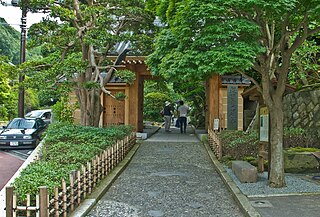
Hōkoku-ji (報国寺) is an old temple in the Kenchō-ji school of the Rinzai sect of Zen Buddhism located in Kamakura, Japan. Famous for its bamboo garden, it is also known as "Bamboo Temple".
Mugaku Sogen (無学祖元), also known as Bukko Kokushi was a prominent Zen Buddhist monk of the 13th century in Japan, an emigre from Song dynasty China. He was adviser to Japan's most powerful ruler of the day, the regent of the shōgun (Shikken) Hōjō Tokimune. He founded the Zen temple Engaku-ji in Kamakura, one of Japan's five most important Zen temples.





